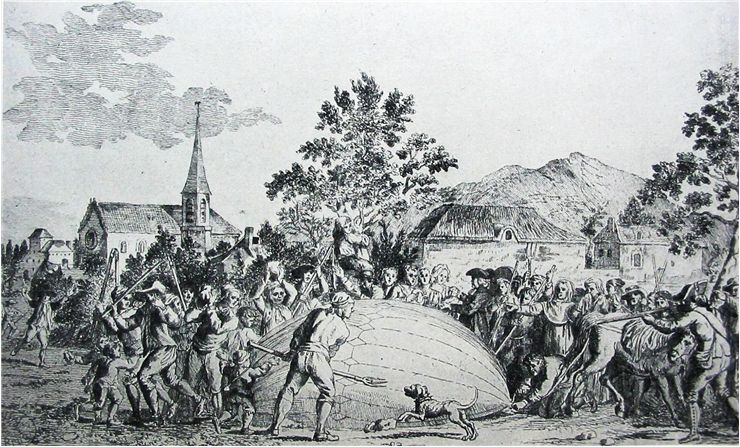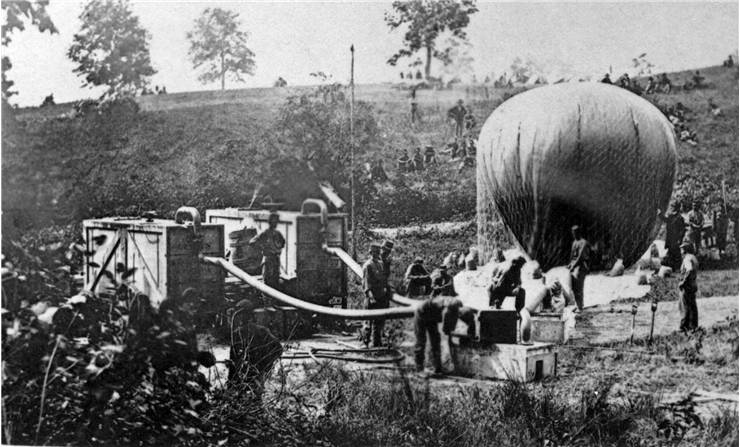Gas Balloons - History and Invention of First Gas Balloons
Gas balloon is a balloon filled with gas. Gas can be lighter than air (helium or hydrogen) or not. Gas balloons file filled with a gas that is lighter than air can fly. They can also be called a Charlière for its inventor, the Frenchman Jacques Charles.
Idea to use a gas lighter than air began with Henry Cavendish's 1766 work on hydrogen, and Robert Boyle's Boyle's Law from 1662. Joseph Black also proposed that a balloon filled with hydrogen would rise in the air. Professor Jacques Charles studied them and Tiberius Cavallo and decided to try these ideas in practice. He designed the hydrogen balloon, while the Robert brothers invented the way to construct the lightweight, airtight gas bag - a balloon. They used the sheets of silk which were varnished with rubber dissolved in turpentine. That made silk airtight. The world's first hydrogen-filled balloon was launched on August 27, 1783 from the Champ de Mars, Paris. It was relatively small balloon that could lift some 9kg but it was the first. Hydrogen needed for the balloon was made by pouring nearly a quarter of a tone of sulphuric acid onto half a ton of scrap iron and fed into a balloon via lead pipes. The balloon flew 21km for 45 minutes and landed in the village of Gonesse. It was there welcomed by frightened villagers that attacked it with pitchforks and knives and destroyed it.
Few days after the Brothers Montgolfier launched their manned flight of a hot air balloon, Professor Jacques Charles and the Robert brothers launched a new, manned hydrogen balloon from the Jardin des Tuileries in Paris at 13:45 on December 1, 1783. Jacques Charles and Nicolas-Louis Robert (one of the brothers) were the first pilots of a balloon that was fitted with a hydrogen release valve and sand ballast for altitude control, and covered with a net from which the basket was suspended. The flight itself lasted 2 hours and 5 minutes and covered 36km with a maximum altitude of 550m. They landed at sunset in Nesles-la-Vallée but Charles decided to ascend again, alone. He managed to achieve altitude of 3,000m. There he felt a strong pain in his ears and decided to land. This was also the first balloon flight to provide meteorological measurements of the atmosphere above the Earth's surface because Charles and Robert carried a barometer and a thermometer with them to measure the pressure and the temperature of the air.
After this flight, Jacques Charles and Robert Brothers made “La Caroline” - an elongated steerable craft that had an internal air cells, rudder and a method of propulsion. This was proposed by Jean Baptiste Meusnier, French mathematician, engineer and Revolutionary general. On September 19, 1784 the Robert Brothers and M. Collin-Hullin made a flight with “La Caroline” that lasted for 6 hours 40 minutes, and crossed 186km from Paris to Beuvry near Béthune which makes it the first flight longer than 100km.
Gas balloons remained popular before airplanes appeared in the sky. They could achieve greater altitudes that hot air balloons and fly further. They were also more dangerous because they used hydrogen which could explode. Reason for using hydrogen instead of helium (which is inert and safe) is because hydrogen is easier to obtain. Gas ballooning is still popular in Europe, most notably in Germany, while in the United States less so.
Altitude record for a manned balloon flight with a gas balloon was set on October 14, 2012 by Felix Baumgartner who rose to the altitude of 39.045km. He broke a record of 34.7km which was set by Malcolm Ross and Victor Prather on May 4, 1961.

